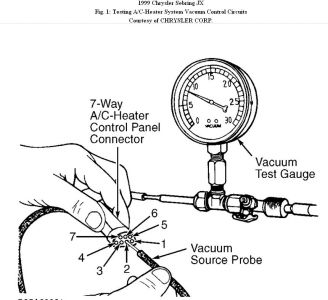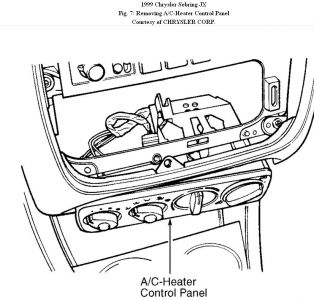VACUUM CONTROL SYSTEM DIAGNOSIS
VACUUM CONTROL ONE-WAY CHECK VALVE
1.In engine compartment, locate Black vacuum hose that runs from brake booster check valve or intake manifold, through firewall near heater hoses or expansion valve. This supply vacuum hose goes to A/C-heater control panel vacuum switch.
2.Within Black vacuum hose, disconnect and remove check valve near intake manifold or brake booster. Connect vacuum gauge to an external vacuum pump. Start vacuum pump. Plug end of hose probe on vacuum gauge. Adjust bleed valve on vacuum gauge to obtain an exact vacuum reading of 8 in. Hg.
3.Unplug and plug end of hose probe on vacuum gauge several times to ensure exact vacuum reading. Connect vacuum gauge hose probe to control panel side of check valve. Vacuum gauge reading should be 8 in. Hg. Replace check valve if vacuum leak exists.
4.Connect vacuum gauge hose probe to engine side of check valve. Vacuum should flow through check valve. Replace check valve if operation is not as described.
VACUUM CONTROLS
1.This test checks for proper function of control panel vacuum circuits. Perform steps 1) through 4) under VACUUM CONTROL ONE-WAY CHECK VALVE.
2.Connect vacuum gauge hose probe to Black vacuum hose end that leads to A/C-heater control panel switch. Position vacuum gauge so gauge reading can be observed from inside vehicle.
3.Operate A/C-heater controls (sliding lever or push buttons) in all mode positions (floor, defrost, panel, etc.). Pause after each selection to allow vacuum actuators or motors to energize and stabilize. Record vacuum gauge reading at each selection.
4.After each selection, vacuum reading should be 7.5-8 in. Hg. Maximum vacuum reading drop is .75 in. Hg. If proper vacuum reading cannot be obtained, vacuum leak exists in selected circuit.
5.To check for vacuum leak(s), disconnect 7-way A/C-heater control panel vacuum harness connector. See Fig. 1 . If necessary, remove control panel from instrument panel to access A/C-heater control panel vacuum harness connector, or remove lower instrument panel assembly.
6.Connect vacuum source probe to each port of connector. See Fig. 1 . Record each vacuum gauge reading. Vacuum reading should be 8 in. Hg at each port.
7.If correct vacuum readings are obtained, replace faulty A/C-heater control panel vacuum switch assembly. If proper vacuum readings are not obtained, check appropriate vacuum circuit.
8.Start vacuum check by plugging vacuum hose at vacuum actuator in suspect circuit. Recheck vacuum circuit by connecting vacuum source probe to proper port.
9.If proper vacuum reading is now obtained, replace vacuum actuator. If proper reading is not obtained, check vacuum hoses and connections for leak. Repair or replace as required.
NOTE:
Some models use brake booster check valve for vacuum source. These models do not use another in-line vacuum check valve.
NOTE:
Brown (bi-level) vacuum circuit contains a restriction in line. It takes longer to obtain correct vacuum reading on this line.

Saturday, August 14th, 2010 AT 10:05 AM


